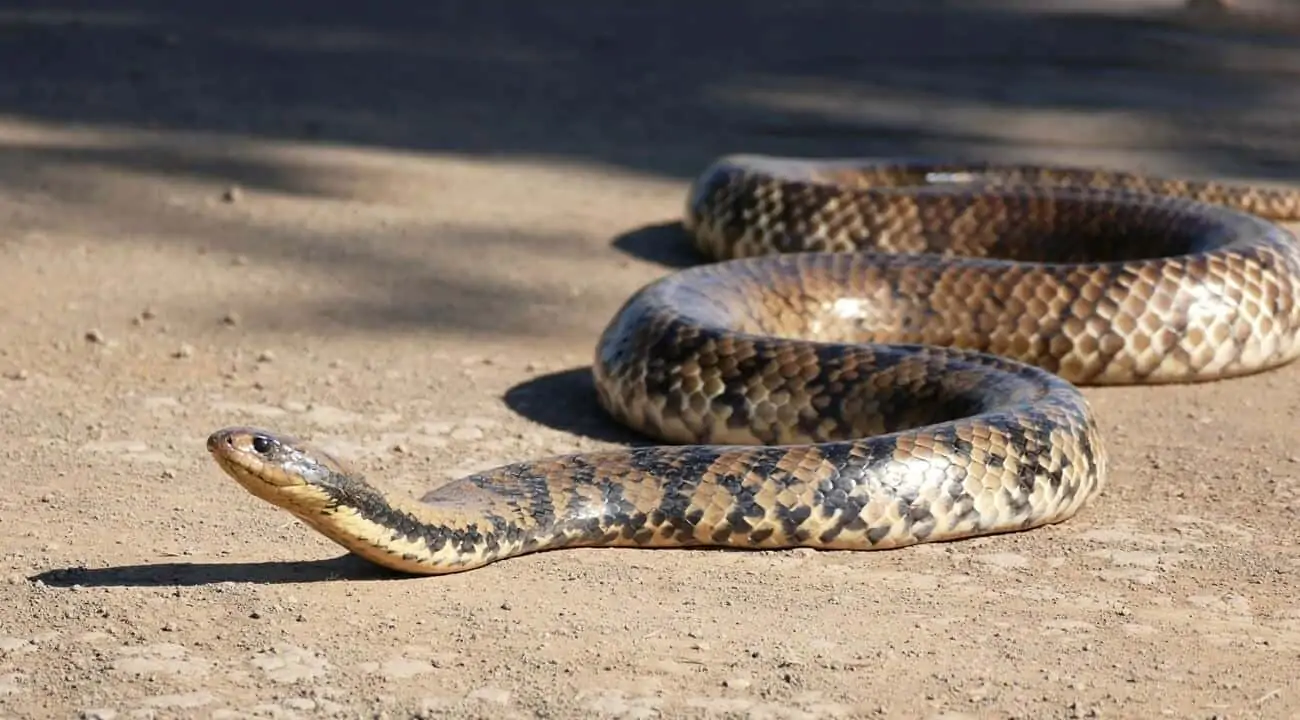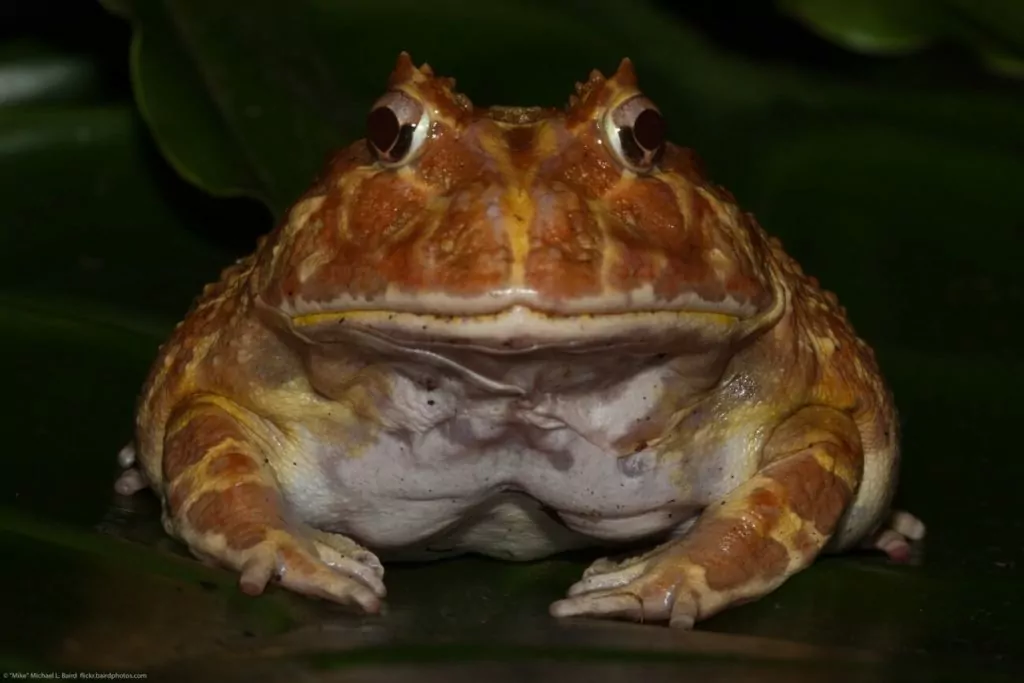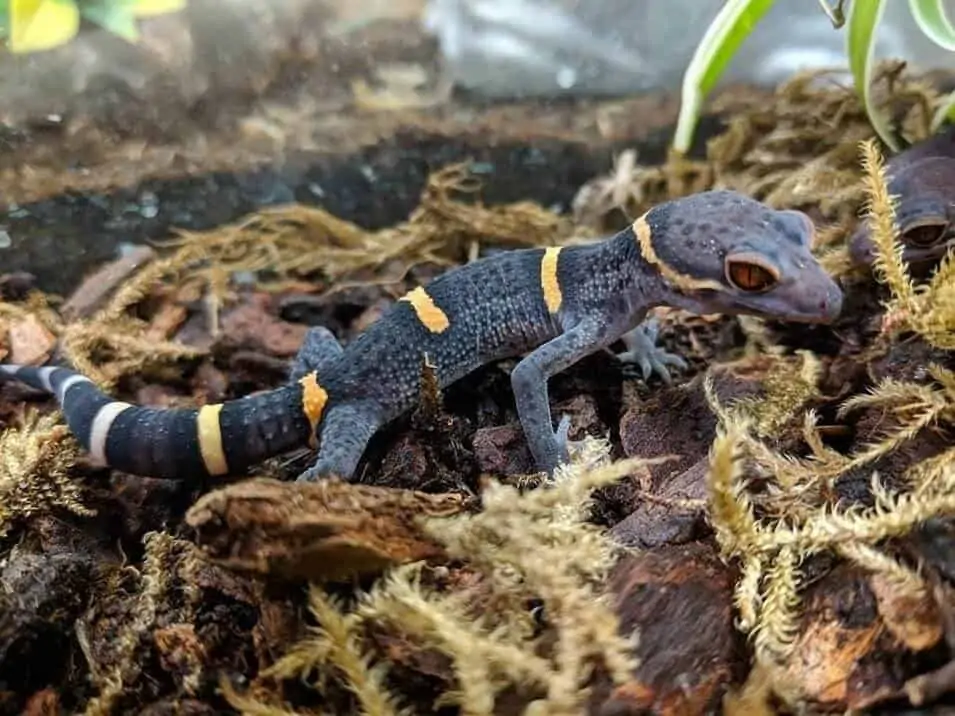False Water Cobras are a very misunderstood snake that actually make great pets!
We’ve gotten so many questions about this species over the years, that we felt it was important to create a formal care guide for them.
You see, there’s a lot of conflicting information being shared online about this snake. Some people say they’re easy to care for, and others say they’re extremely challenging. Other folks claim this species is dangerous, and others do the opposite.
So we’re going to clear everything up for you. This guide will cover everything you need to know about False Water Cobra care, and help you better understand this species as a whole.
Table of Contents
Species Summary
First, don’t let the name of this snake species scare you off!
While they share a similar name to the deadly snake, the False Water Cobra is not a true cobra at all. It doesn’t even belong in the same family.
Sometimes referred to as the Brazilian Smooth Snake, the False Water Cobra (Hydrodynastes gigas) is an interesting species to care for. This isn’t a snake for novice reptile keepers. Not only does it have some distinct care requirements, but this snake also produces venom.
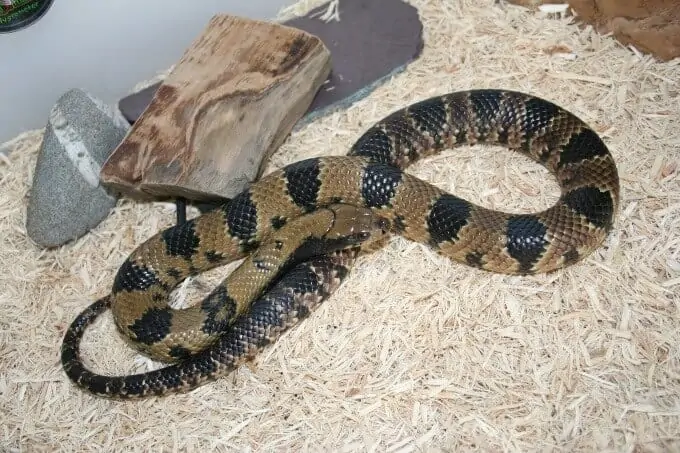
The False Water Cobra is endemic to South America. It can be found throughout Brazil, Paraguay, Bolivia, and Northern Argentina.
Most of the snakes you’ll find in captivity these days were not wild-caught. This species is frequently bred in captivity, leading to a healthy supply of parasite-free snakes for reptile enthusiasts around the globe.
Lifespan
In captivity, the average lifespan of False Water Cobras is between 12 and 20 years.
These snakes are known to live a bit longer in the wild. Some specimens have been reported to live beyond the 20-year mark, but it’s a rare occurrence.
Even for the standard 12 to 20-year life expectancy, there are no guarantees with the False Water Cobra. Like any other reptile, these snakes are at the whims of their environment and care. If you don’t provide the best husbandry possible, these snakes are far more prone to experiencing illness and even premature death.
Appearance & Colors
So, why does this snake have its unique name? Well, it all comes down to its most identifying feature.
The False Water Cobra has a hood similar to the one that you find on a King Cobra. This hood is made out of appendages that come out of the neck vertebrae. Whenever the snake is feeling threatened, they may flare these appendages out to create that intimidating hood.
If you’ve ever seen a King Cobra in person, you’ll notice that the False Water Cobra has a much smaller hood. That said, it’s still quite scary for those who don’t know the difference!
Depending on the age and size of the snake, the hood can be between four and eight inches wide.
Thanks to the many False Water Cobra breeders, there are a few distinct color morphs available. The most common is considered to be the standard.
These snakes have splashes of yellow, brown, and black. Typically, black bands or large squares will run down the length of the body. Yellow highlighting around the black portion creates a beautiful look.
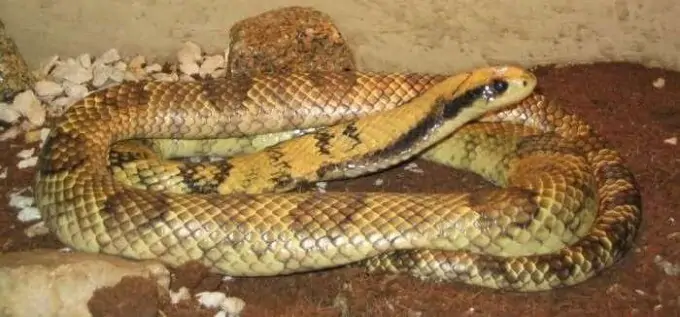
Other morphs include “Hypo” and “Lavender.” Hypo snakes don’t have as much brown and black. Instead, their bodies are covered in shades of yellow, orange, and light brown.
Lavender False Water Cobras are quite rare. However, they are a beautiful sight to behold if you can get your hands on one! Instead of the standard warm colors, these snakes are gray and light purple.
Expert Tip: These snakes are sexually dimorphic, which means that males and females are relatively easy to distinguish. Females are the bigger sex. They are much girthier and can get considerably longer than males.
Average Size
The average of a False Water Cobra depends on if you’re dealing with a male or female.
Female Water Cobras can reach lengths of eight feet! Some females might not get that long, but most are going to be somewhere between six and eight feet. On the upper end of the scale, they will weigh about 10 pounds.
Males are a bit smaller, and will usually stay around four to five feet long.
False Water Cobra Care
False Water Cobra care is definitely not a walk in the park. These snakes can be tricky if you don’t have a solid amount of experience.
That said, it is manageable if you know what you’re doing (and have a bit of guidance). In fact, providing the base-level requirements for this pet snake isn’t a very complex process. As long as you cover the essentials, you shouldn’t have too many problems keeping the snake in good shape.
Enclosure Size
The most important thing you’re going to need is a high-quality enclosure. Because they get so large, a standard tank isn’t going to cut it.
For healthy adults, an enclosure should measure at least 48 inches long, 24 inches deep, and 18 inches high. That will be sufficient for a single False Water Cobra.
However, we recommend getting an even bigger enclosure if you have space.
An environment that’s 72 inches long, 30 inches deep, and 18 inches tall is much better if you have the room. This will provide ample space for the snake to explore without feeling cramped.
Go for an enclosed tank with at least one side opened for ventilation. Equip that open side with a durable screen top to prevent escape (these reptiles can get curious from time to time). The ventilated top should also help to regulate humidity levels a bit.
What To Put In Their Tank
False Water Cobras are unique in that they enjoy a well-designed environment. Most snakes aren’t super picky about things like decorations.
However, this species is.
Starting at the bottom of the enclosure, apply a nice layer of absorbing substrate. The best option would be cypress mulch or orchid bark. Avoid anything that’s treated with chemicals.
A wood-based substrate offers a couple of benefits. First, it regulates humidity levels by holding onto the water. Secondly, it helps keep things clean. False Water Cobras are notorious for being messy. A substrate that’s able to absorb messes can make all the difference.
Expert Tip: Some owners even like to make their own substrate. You could mix the mulch with topsoil and sand for a better texture. Throw in some superworms to take care of feces and you’ll have a biologically diverse enclosure.
On top of the substrate, add some natural-looking decorations. Sanitized driftwood, large pieces of cork bark, and smooth rocks are all good options.
You can also utilize live plants. However, these tend to get destroyed pretty quickly by larger snakes.
Don’t forget to implement a hide box too! A large hide box will be your snake’s sanctuary and place where they feel safe, so it’s a must-have for the enclosure.
Temperature & Lighting
False Water Cobras prefer warmer climates and plenty of opportunities to regulate their temperature.
The best way to arrange your tank’s lighting system is to create a temperature gradient. This means one side of the tank will be slightly cooler than the other.
On the cooler side, keep ambient temperatures between 78 and 85 degrees Fahrenheit.
Expert Tip: If you live in an area that gets colder at night, consider investing in heat emitters or under-tank heating pads.
As for the hotter side of the tank, you’ll need to invest in a basking light. These powerful lights can produce considerably hotter temperatures.
This basking area should be between 90 and 95 degrees Fahrenheit.
Another important consideration is UVB lighting. Ideally, you would utilize a dual-purpose UVB lamp for the enclosure’s main lighting system. Implementing a UVB bulb into the setup will ensure that your snake is getting all the vitamins they need!
Without direct exposure to the sun, the False Water Cobra could encounter some issues with calcium metabolism. The UVB light will address that problem.
Humidity
Humidity levels in the enclosure should hover around 50 to 60 percent.
The substrate you use will help to maintain those levels. However, you should never assume that humidity is right. Purchase a hygrometer and check those levels frequently to be sure.
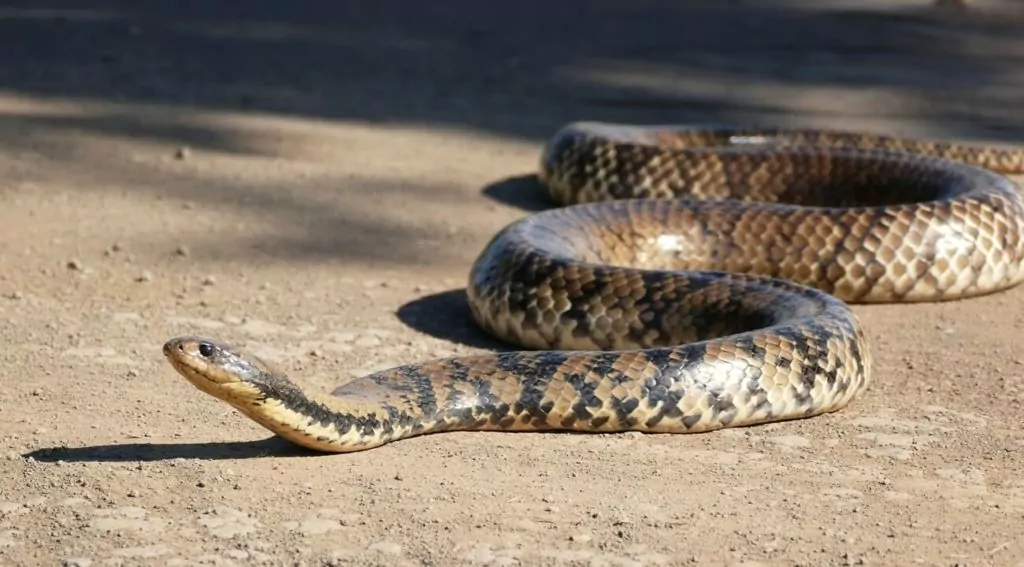
If things start to get dry, just mist the enclosure a bit. Don’t overdo it, though! Too much humidity could result in respiratory problems and infections.
Water
A sizable water basin is needed for your snake’s enclosure. False Water Cobras typically live in wetlands in the wild. Thus, they have a penchant for soaking!
Use a basin that’s large enough for your snake to get in anytime they want.
Make sure that you keep an eye on the basin and replace water frequently. The snake will more than likely tip over the basin or defecate in the water.
Expert Tip: To avoid parasites and bacterial infections, you’ll need to provide fresh and filtered water at all times.
False Water Cobra Food & Diet
False Water Cobras have a healthy appetite. Unlike other species that tend to be more relaxed about the feeding process, these snakes always get excited! They will strike their food dramatically and often put their meal through the wringer.
They’re known to slam the food around the enclosure. This happens even if the meal is already dead!
There’s no shortage of food options of the False Water Cobra. They are more than willing to accept any protein-based food. So, you can provide live or defrosted:
- Pinkies
- Adult mice
- Large rats
- Chicks
- Fish
- Frogs
Generally, you should provide food that’s equivalent to the width of your snake’s head. These guys grow fast, so you’ll need to change foods pretty often.
Juvenile False Water Cobras that are still growing should be fed weekly to support their metabolism. Once the snake has reached its max size, you can slow down to every other week.
Potential Health Issues
False Water Cobras aren’t immune to health problems. Like any other snake species, they can encounter parasitic infections, bacterial infections, respiratory problems, scale rot, and more.
In fact, respiratory infections are pretty common. It’s usually caused by humidity levels that are too high. This causes the inner lining of the mouth to become swollen or infected as a result.
Luckily, you can treat the condition with some antibiotics.
Remember, most of the diseases these snakes are susceptible to are completely avoidable. Just maintain the enclosure and check the conditions regularly. Staying on top of humidity, temperature, and water quality will play a big part in keeping issues at bay.
Behavior & Temperament
False Water Cobras are one of the more active snake species and are known for being very alert. They will also get to know you over time and may even start to recognize you when you approach the enclosure.
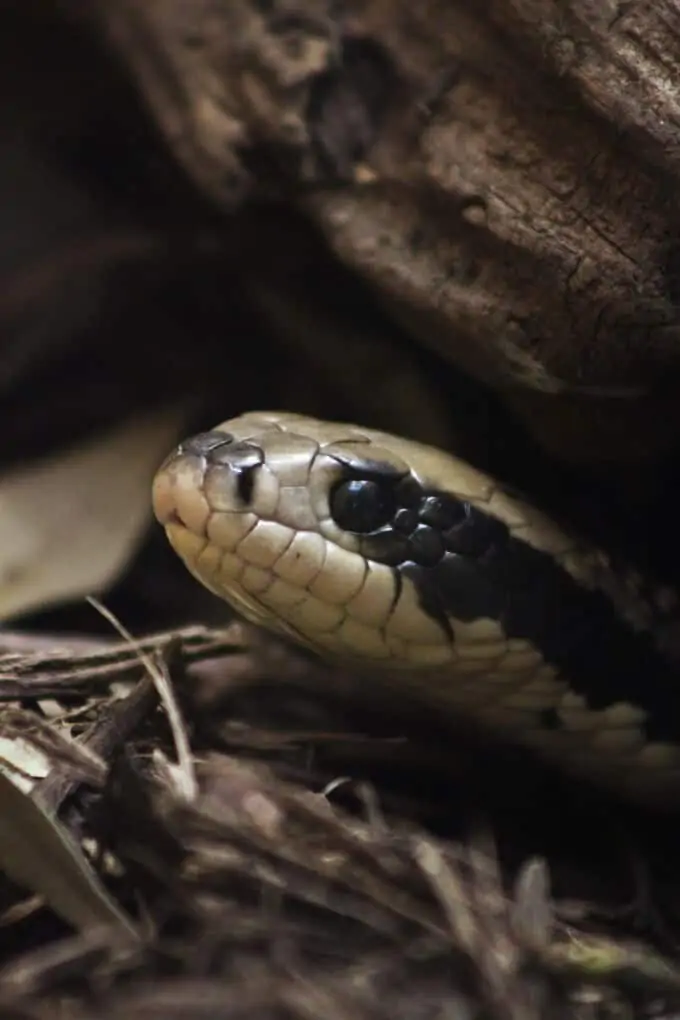
When they are not being fed, most False Water Cobras will spend their days curled up in the hide box. You might witness the occasional soak, too.
It’s important to note that these snakes are capable of biting (duh). Biting is not too common in captivity, but it’s possible if you agitate the snake or catch it by surprise.
The False Water Cobra has large grooved teeth in the back of the mouth. They’re very sharp and can lead to a nasty wound if bitten. Not only that, but the teeth connect to glands that secrete venom. False Water Cobras deliver venom by chewing on their food.
Luckily, bites are usually quick. Because of this, most people aren’t affected by the venom during a bite.
Handling Them
False Water Cobras should be handled with respect. You must be cautious and ensure that you’re approaching the snake gently.
Many owners prefer to use a snake hook when handling the False Water Cobra. This is a good idea if you’re worried about being bitten. The hook will keep the snake’s head at a healthy distance and help you react safely if the snake strikes.
The good news is that False Water Cobras often give warning before they strike.
Expert Tip: Whether you’re handling the snake by hook or hand, learn to read their body language! When you see that hood start to flare out, back away and give your snake a minute to get comfortable.
When they’re ready, support the snake’s body at their thickest point. They should wrap around your hand slightly.
Overall, you should keep handling to a minimum. This isn’t a species that you’re going to be cuddling with! Occasional handling is fine, but it should never be a frequent thing.
Now You’re Ready (And Well-Informed)
As you can tell, False Water Cobra care has many layers in terms of difficulty. Some parts are straightforward, and others can be a bit challenging.
But at the end of the day, you now have an accurate understanding of what this species is (and what it needs to thrive).
It’s now up to you to decide if owning one as a pet is what you want. Like we said earlier, owning a False Water Cobra isn’t a piece of cake.
However, it’s very rewarding. Their long lifespan, high activity level, and ability to recognize their owner makes them great if you’re looking for a snake to bond with.
No matter what you decide, we wish you the best of luck! As always, you can reach out to us directly with questions at any time.

